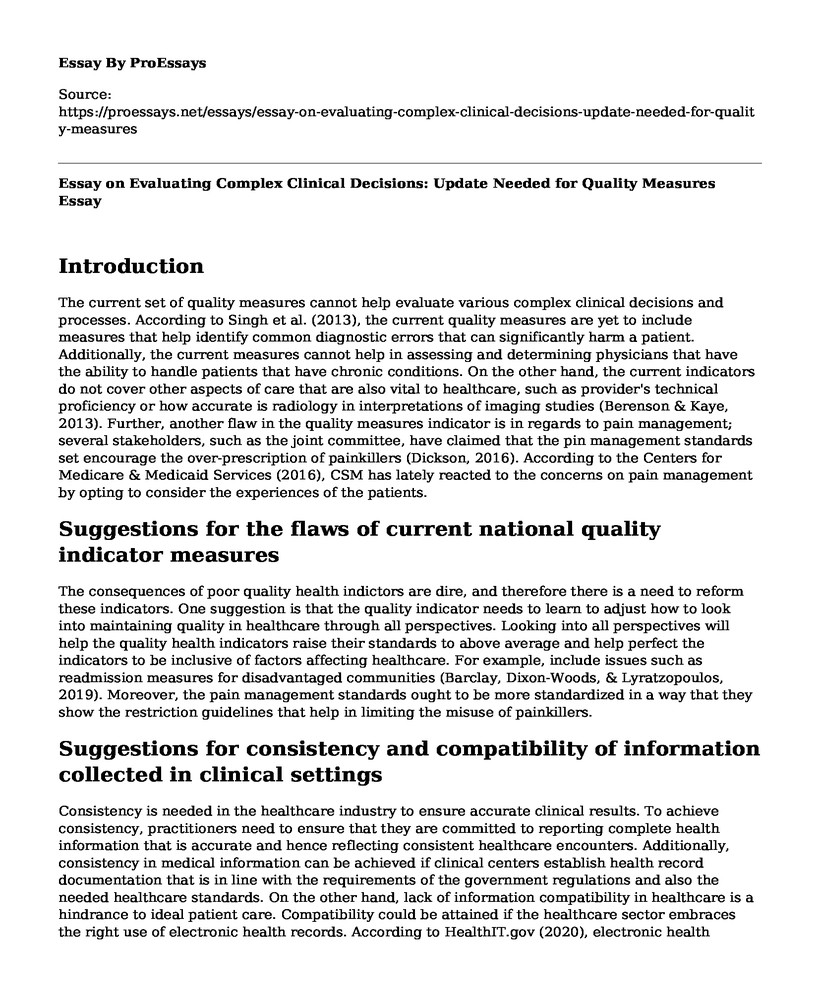Introduction
The current set of quality measures cannot help evaluate various complex clinical decisions and processes. According to Singh et al. (2013), the current quality measures are yet to include measures that help identify common diagnostic errors that can significantly harm a patient. Additionally, the current measures cannot help in assessing and determining physicians that have the ability to handle patients that have chronic conditions. On the other hand, the current indicators do not cover other aspects of care that are also vital to healthcare, such as provider's technical proficiency or how accurate is radiology in interpretations of imaging studies (Berenson & Kaye, 2013). Further, another flaw in the quality measures indicator is in regards to pain management; several stakeholders, such as the joint committee, have claimed that the pin management standards set encourage the over-prescription of painkillers (Dickson, 2016). According to the Centers for Medicare & Medicaid Services (2016), CSM has lately reacted to the concerns on pain management by opting to consider the experiences of the patients.
Suggestions for the flaws of current national quality indicator measures
The consequences of poor quality health indictors are dire, and therefore there is a need to reform these indicators. One suggestion is that the quality indicator needs to learn to adjust how to look into maintaining quality in healthcare through all perspectives. Looking into all perspectives will help the quality health indicators raise their standards to above average and help perfect the indicators to be inclusive of factors affecting healthcare. For example, include issues such as readmission measures for disadvantaged communities (Barclay, Dixon-Woods, & Lyratzopoulos, 2019). Moreover, the pain management standards ought to be more standardized in a way that they show the restriction guidelines that help in limiting the misuse of painkillers.
Suggestions for consistency and compatibility of information collected in clinical settings
Consistency is needed in the healthcare industry to ensure accurate clinical results. To achieve consistency, practitioners need to ensure that they are committed to reporting complete health information that is accurate and hence reflecting consistent healthcare encounters. Additionally, consistency in medical information can be achieved if clinical centers establish health record documentation that is in line with the requirements of the government regulations and also the needed healthcare standards. On the other hand, lack of information compatibility in healthcare is a hindrance to ideal patient care. Compatibility could be attained if the healthcare sector embraces the right use of electronic health records. According to HealthIT.gov (2020), electronic health records are a step closer to achieving compatibility of information collected as they have helped practitioners quickly access patient's records, and also, help practitioners regularly update a patient's information and hence improving the compatibility of the information given.
Measure the extent to which care that is provided is evidence-based
The care provided by clinical officers is, to a great extent, evidence-based. Therefore, it is important to ensure that practitioners provide evidence-based care to their patients. According to Djulbegovic and Guyatt (2017), physicians conduct numerous research, for example, from randomized control trials, clinical practice guidelines, and systematic reviews before making clinical judgments and clinical decisions. Hence to achieve evidence-based care, medical professionals need to ensure that they have good knowledge that is based on the research and consultations they have done before treating a patient. Additionally, evidence-based practice is also based on the correct understanding and interpretation of the patient's information (Nunan et al., 2017). Therefore, practitioners willing to achieve evidence-based practice needs to match their treatment and care options with the tastes and preferences of their patients. Further, to achieve evidence-based practice, the practitioners need to ensure that they handle the patient will the ideal and required clinical expertise and maintain professionalism.
References
Barclay, M., Dixon-Woods, M., & Lyratzopoulos, G. (2019). The problem with composite indicators. BMJ Qual Saf, 28(4), 338-344.
Berenson, R. A., & Kaye, D. R. (2013). Grading a physician's value-the misapplication of performance measurement. N Engl J Med, 369(22), 2079-2081.
Centres for Medicare & Medicaid Services. (2016). "CMS Finalizes Hospital Outpatient Prospective Payment System Changes to Better Support Hospitals and Physicians and Improve Patient Care" www.cms.gov/Newsroom/MediaReleaseDatabase/Press-releases/2016-Press-releases-items/2016-11-01.html.
Dickson, V. (2016, July 6). CMS angers hospitals with plans for site-neutral rates in outpatient payment rule. Retrieved from https://www.modernhealthcare.com/article/20160706/NEWS/160709964/cms-angers-hospitals-with-plans-for-site-neutral-rates-in-outpatient-payment-rule
Djulbegovic, B., & Guyatt, G. H. (2017). Progress in evidence-based medicine: a quarter-century on. The Lancet, 390(10092), 415-423.
HealthIT.gov. (2020). What are the advantages of electronic health records? | HealthIT.gov. Retrieved from https://www.healthit.gov/faq/what-are-advantages-electronic-health-records
Nunan, D., Sullivan, J. O., Heneghan, C., Pluddemann, A., Aronson, J., & Mahtani, K. (2017). Ten essential papers for the practice of evidence-based medicine. BMJ Evidence-Based Medicine, ebmed-2017.
Singh, H., Giardina, T. D., Meyer, A. N., Forjuoh, S. N., Reis, M. D., & Thomas, E. J. (2013). Types and origins of diagnostic errors in primary care settings. JAMA internal medicine, 173(6), 418-425.
Cite this page
Essay on Evaluating Complex Clinical Decisions: Update Needed for Quality Measures. (2023, Apr 08). Retrieved from https://proessays.net/essays/essay-on-evaluating-complex-clinical-decisions-update-needed-for-quality-measures
If you are the original author of this essay and no longer wish to have it published on the ProEssays website, please click below to request its removal:
- Paper Example on the Health Acquired Pressure Ulcer Issue
- Power Stratification in Organizations Essay
- Impacts of Stigma on Diabetes - Paper Example
- Lean Value Stream Mapping for Wal-Mart Layaway Paper Example
- How to Make Sales Force Use Technology More Paper Example
- Paper Example on Leadership Traits: My Potential From Childhood
- Value-Based Leadership: a Necessity for Success - Essay Sample







